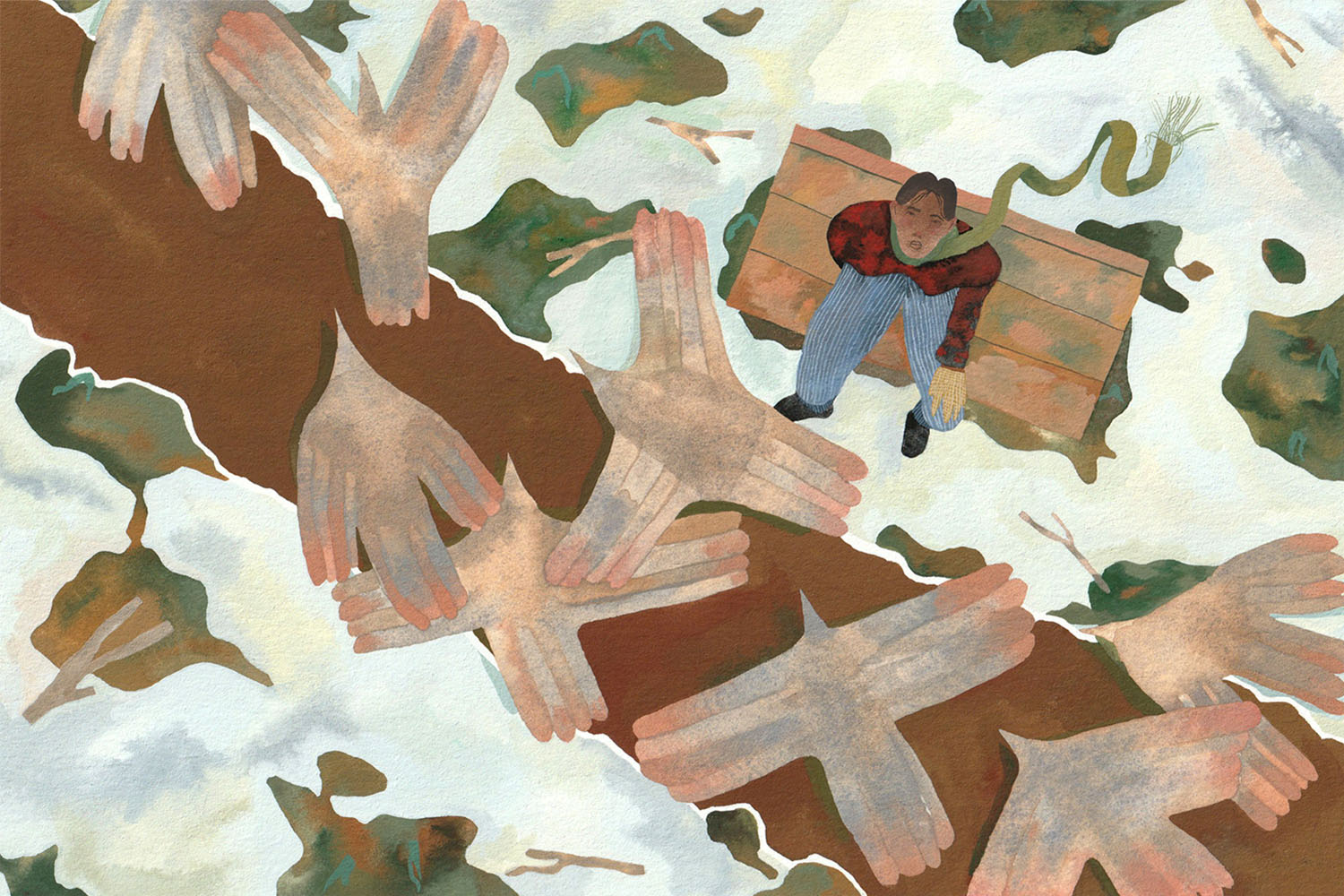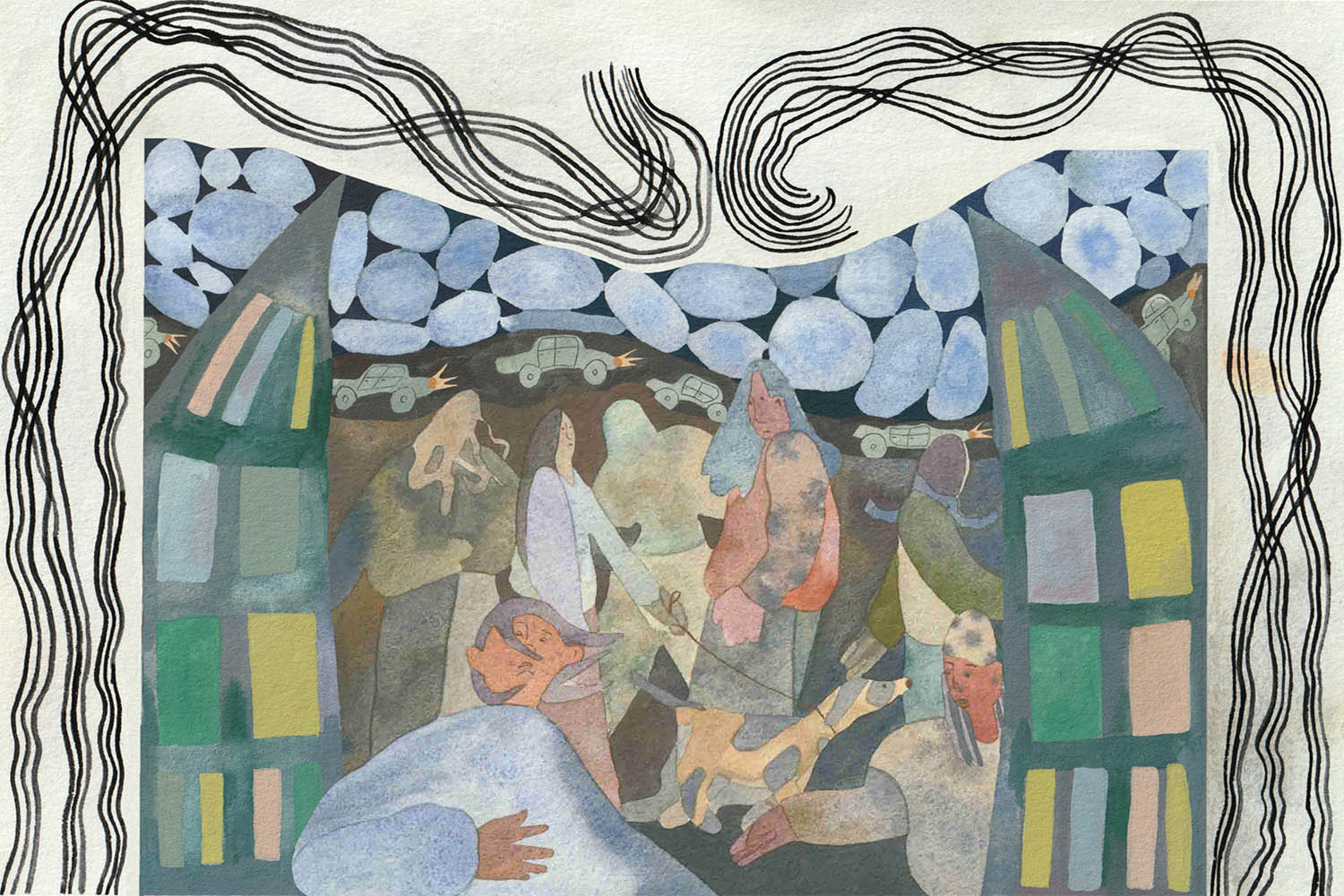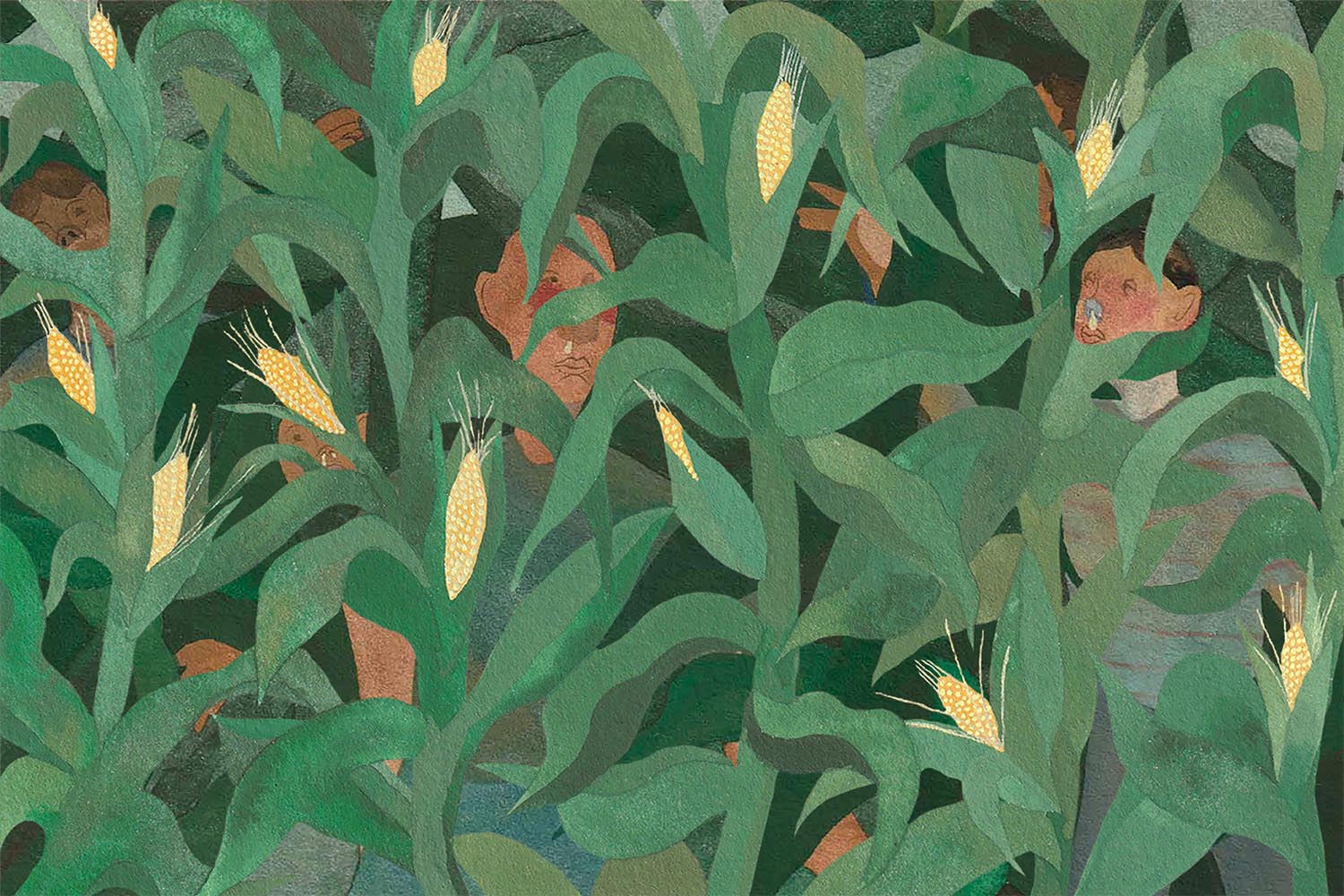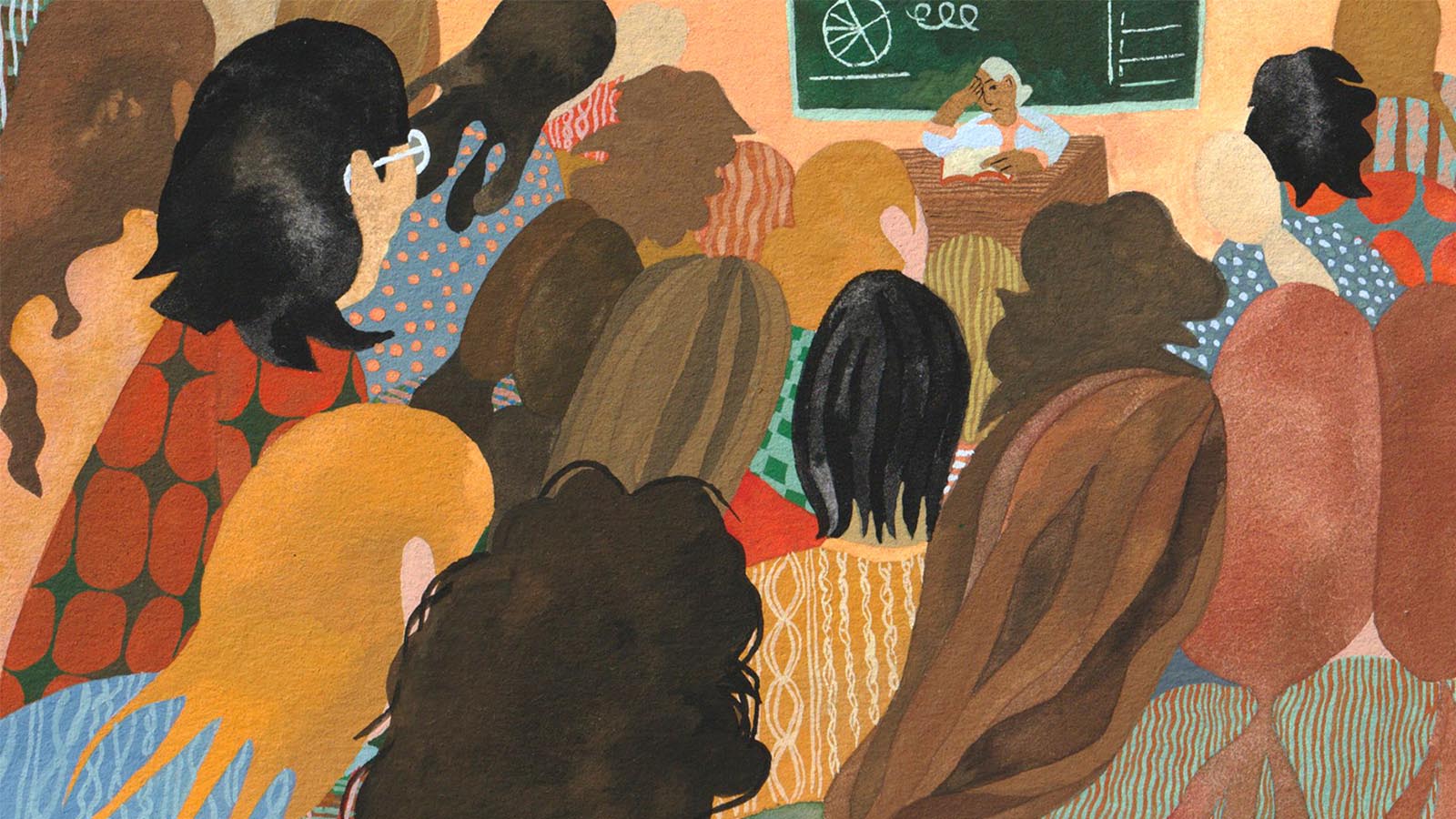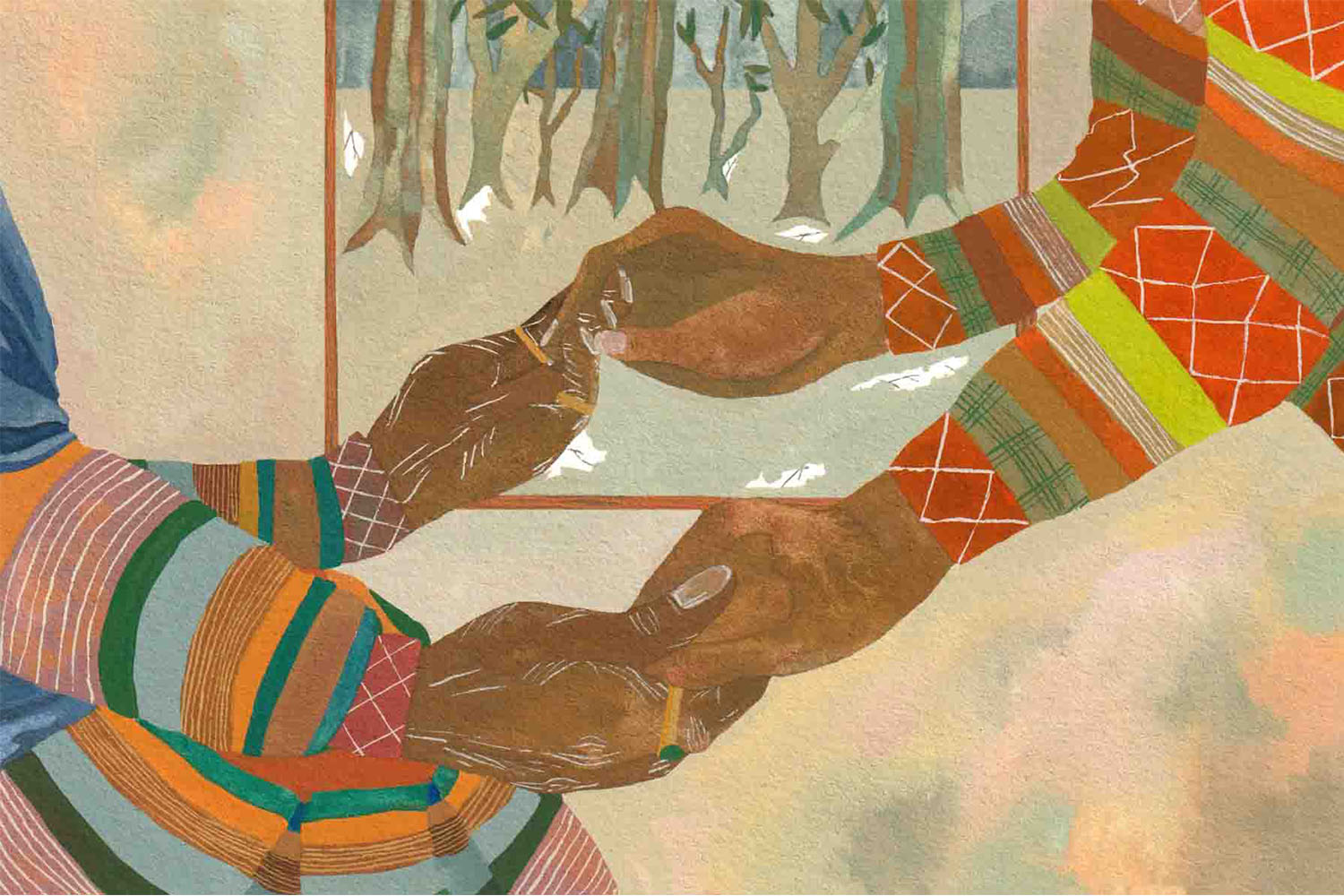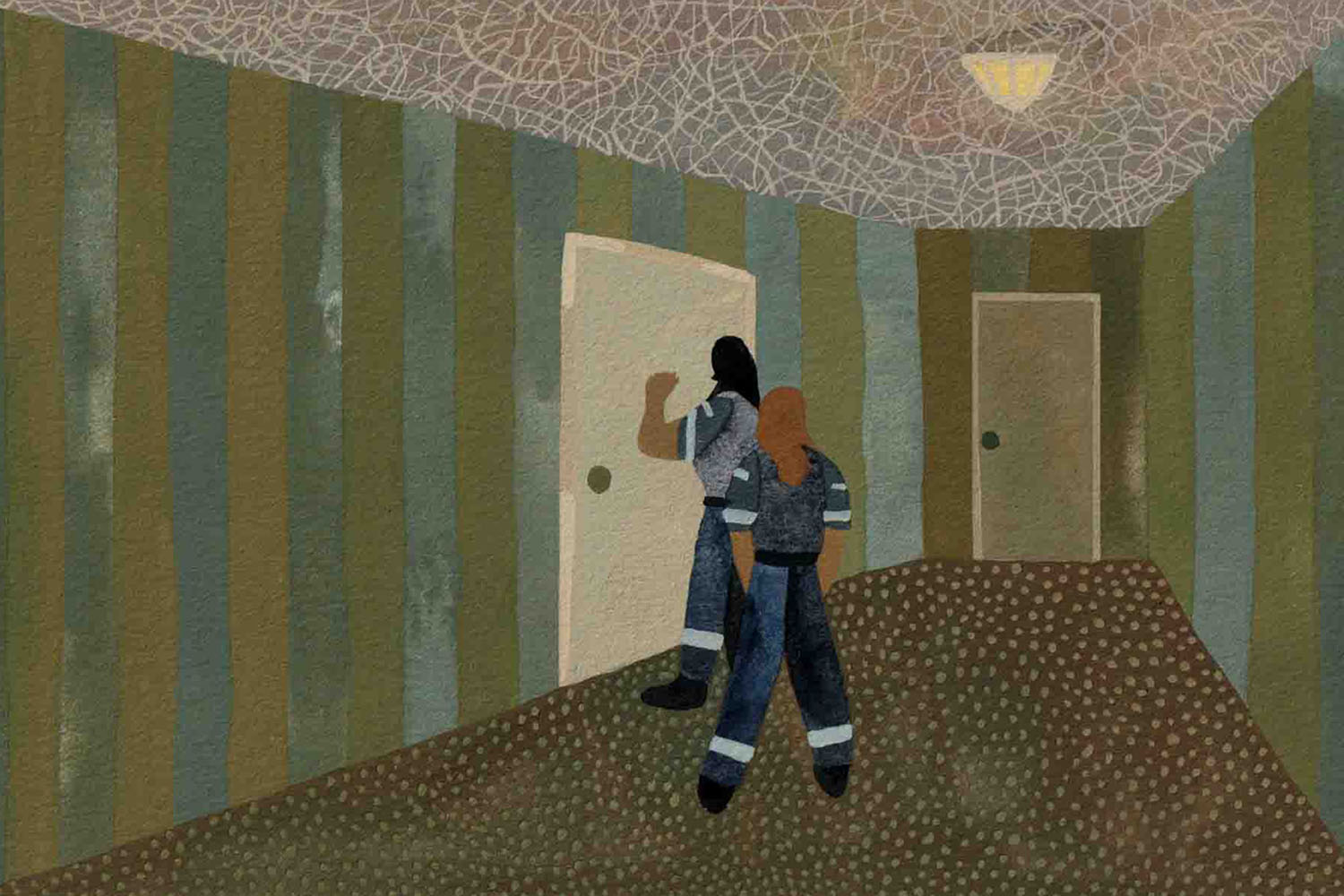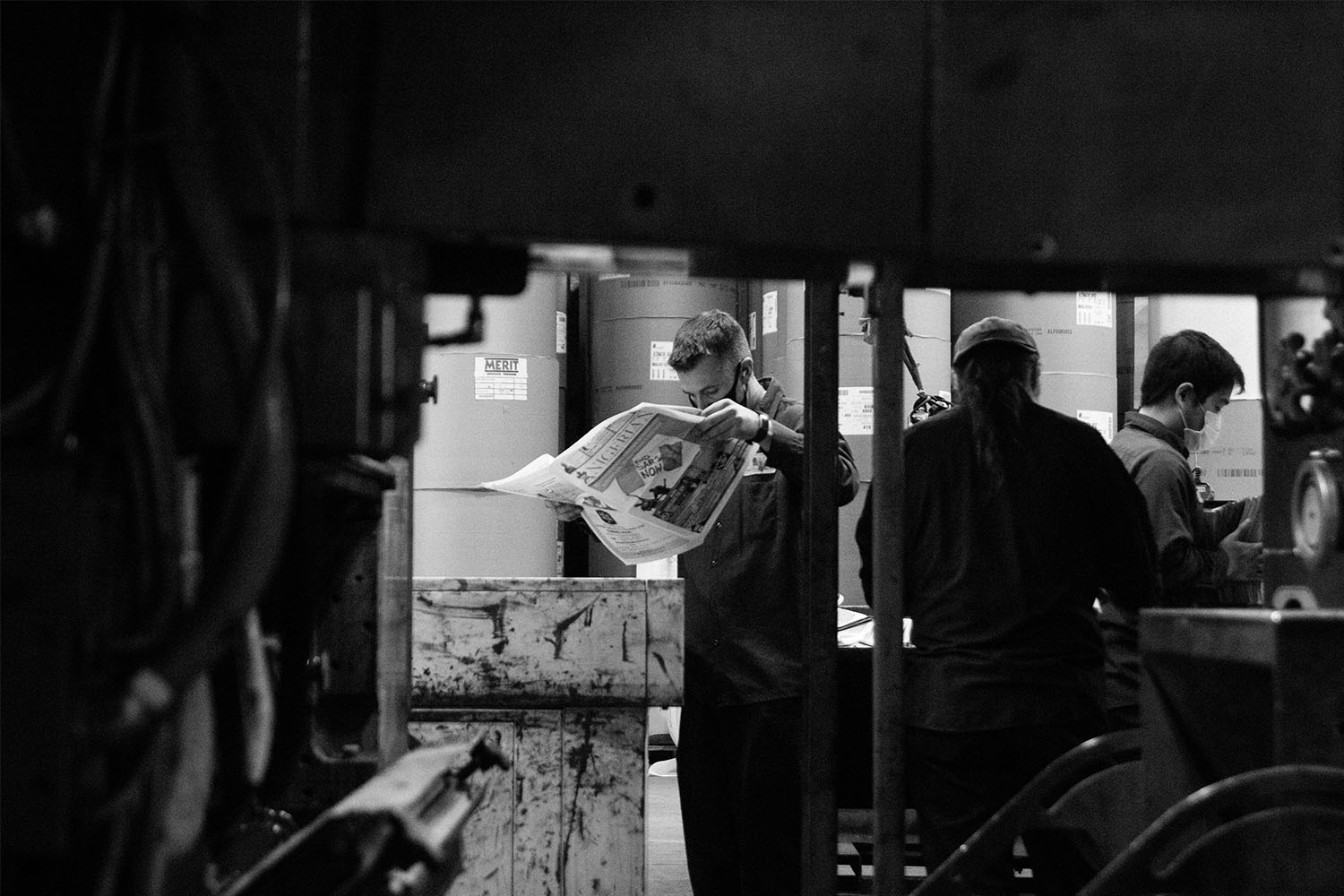
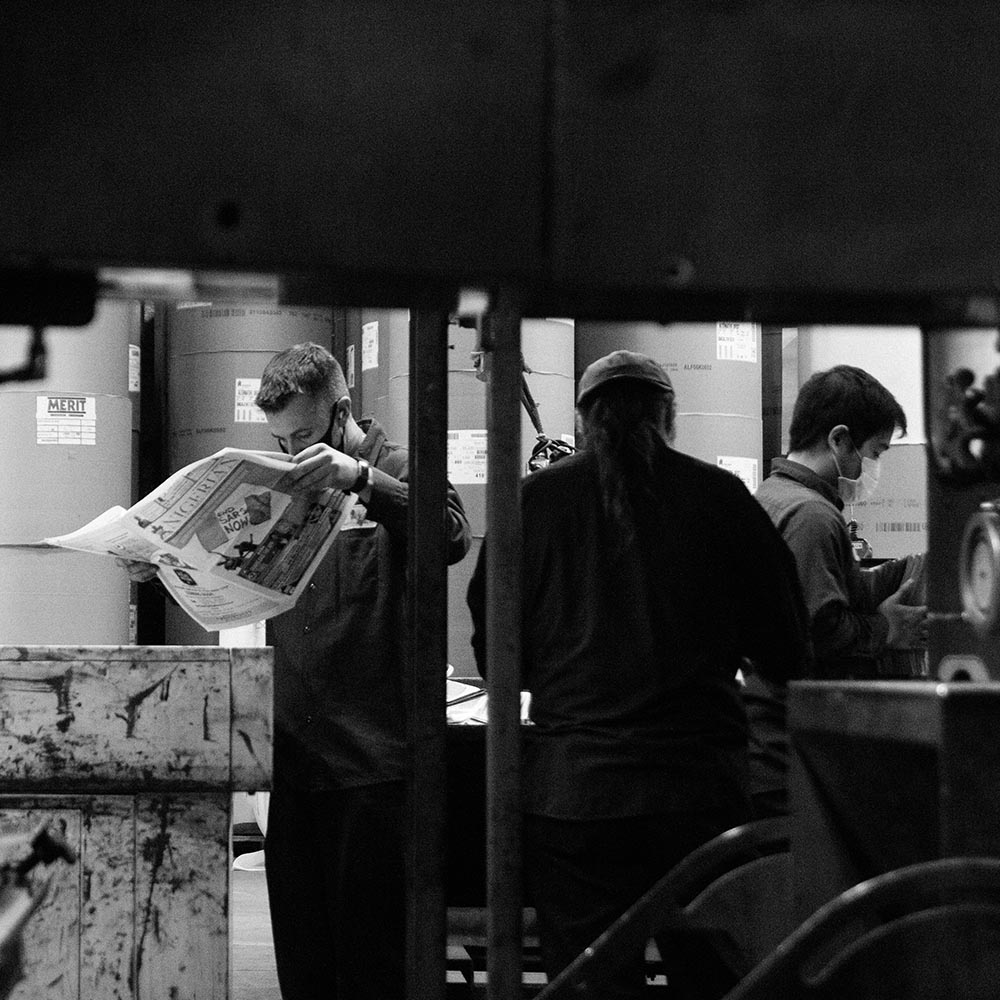
At the corner of Markham and Steeles is a plaza of nearly exclusively Tamil-owned businesses—jewellers and medical centres, take-out joints, and an ice cream parlour where you can add cassava chips to a vanilla cone. On a Friday afternoon in November, customers bustle in and out of the popular grocery store New Spiceland, wheeling red baskets or carrying grey bags of fish caught off the coast of the Caribbean. At the entrance sits a stack of Tamil newspapers from five different publishers available for free. An older gentleman in steel-toe boots stops and selects a copy of Canada Ulahathamilar with an orange headline: “Sri Lanka: Heartbreaking Coronavirus Death Rates.”
For Tamils in Toronto, these newspapers are as natural to pick up at a grocery store as turmeric or Lemon Puff cookies. My grandmother would eagerly await their arrival on our kitchen table, carefully reading them before repurposing them to line containers of freshly fried foods. Plastered with multicoloured ads for real estate agents in three-piece suits, grinning insurance brokers, and even Vedic astrologers, the Tamil press also serves as a directory.
In the spring of 2020, news of COVID-19 began to dominate the front pages of these newspapers. “Leaked Documents Reveal Canada Considers Emergency Declaration” read the April 10 edition of Canada Ulahathamilar, accompanied by a portrait of Trudeau in distress. Uthayan, which has an international bent, shared the COVID-19 infection rates and death toll of various countries, including India and Sri Lanka. Thaiveedu, a monthly paper, took a friendlier tone, with a two-page editorial in its March issue titled “Life and The Virus” that included hopeful lines from the famed Tamil poet Bharathidasan: “Where there is sight, there is evidence of survival.”
As the conditions of the pandemic worsened and daily press conferences revealed updated protocols, the papers became a vital source of information for Tamil audiences. David Asirwatham, a longtime community organizer at Workers’ Action Centre (WAC), has regularly written articles on workers’ rights in Canada Ulahathamilar. During the lockdown he wrote extensively about access to emergency benefits and the right to refuse unsafe work. “Among Tamil workers in precarious situations, language is a huge barrier,” he says. “The Tamil press is an effective entry point in this regard.” As part of his op-eds he included contact information for Milan Nadarajah, a Tamil-speaking caseworker at WAC. “Hundreds of the calls I receive are from uncles and aunties who found my number through the paper,” says Nadarajah.
The Tamil newspapers are just one constellation in a massive galaxy of non-English-language papers, the so-called “ethnic press”— small papers with thin budgets and an outsized influence in Toronto. During COVID-19, these papers have only grown more important. Toronto Public Health data reveal that the most ethno-culturally diverse neighbourhoods in Toronto are experiencing disproportionately higher rates of COVID-19. South Asian people, for example, are three times more likely to contract the virus than white people. These neighbourhoods are abundant in racialized shift workers who are not afforded the luxury of isolation and therefore survival.
Premier Doug Ford’s response has been to ramp up public health messaging, stating: “[we’ll] get more advertising within those communities, no matter if it’s in the mainstream media or the ethnic media.” Ford’s word choice—“no matter”—ascribes equal importance to both ethnic and mainstream media sources as messengers of critical information. For ethnic media producers, however, the pandemic might just be the thing that pushes them over the brink of extinction, after years of systemic underfunding. While a public health crisis has revealed the ethnic press as indispensable to Canada’s media landscape, without foundational support, it has also accelerated its collapse.
The beginning of the ethnic press in Canada can be traced to a German newspaper titled Der Neuschottlaendische Caledar, first published in 1877. Slavic papers emerged shortly after, in the 1910s. And with the influx of migration following the Second World War, an immigrant community’s local press became its footprint in Canada. Today, in a city in which half the residents are immigrants and over 40 percent of the population speaks languages other than English and French, the so-called ethnic press is an essential bridge between Canada and homelands across the globe—with tiny Eritrean publications and big Chinese dailies, Portuguese papers distributed in bakeries, and Iranian press offices along Finch West. Sherry Yu, an assistant professor who studies ethnic/diasporic media at the University of Toronto, points to this evolution to explain the elasticity of ethnic media. “If ethnic media is generational, it wouldn’t be alive today. Ethnic media shares a history of Canadian journalism,” she states. “There is a changing function, but that doesn’t eliminate the actual need for the existence of the media.”
When Logan Logendralingam first arrived in Toronto in 1990, he read Ulahathamilar as a way of maintaining connection to the political upheaval back home. As a refugee, he had fled the island of Sri Lanka following the army’s murder of his brother-in-law. The Tamil newspaper became a conduit to the land he left behind and thumbing through the soft pages soothed the trauma of migration.

It was during his nightly ritual of reading the paper that he stumbled upon a poetry competition which he earnestly entered by mail. In Sri Lanka, Logendralingam was a recognized poet—friends and neighbours would eagerly refer to him as Master, a title reserved for his excellent verse. Sure enough, his poem was awarded second prize by the paper and he was instructed to attend an award ceremony at a high-school gymnasium in Scarborough. He recalls returning to his seat after accepting the award as a career defining moment. “In our culture, there is a love of language,” he says. “Writers are respected.”
For Logendralingam, the Tamil newspaper was a portal between his past and future selves. Three years after the poetry award he launched his own paper, Suriyan, along with four friends. As egos flared and money got tight, Suriyan collapsed, but Logendralingam remained committed. He independently launched Uthayan in 1996. Next year the paper will celebrate 25 years of existence.
Today Uthayan is one of at least eight papers serving a Toronto Tamil community of 157,000 people, delivering news that isn’t covered by the city’s mainstream papers or by the media back home in Sri Lanka. In June, an editorial in Thaiveedu read: “Sri Lanka: Are The Numbers Really Down Or Are They Being Hidden?” It delved into Sri Lanka’s militarized response to the pandemic and the likelihood that the authoritarian government was repressing public health information. It is an article that would not make it to Tamil print in Sri Lanka, a country ranked 127 out of 180 countries by Reporters Without Borders’ World Press Freedom Index with a long history of extreme censorship and persecuting journalists.
At the height of the armed conflict in 2009, there was just one Tamil newspaper reporting from the warzone and international media had been expelled by the state. In Toronto, mass protests against the violence by the Tamil community halted major intersections; mainstream news coverage reported the demonstrations as traffic incidents. A 2009 article in The Globe and Mail labeled “Tamil Trouble” was paired with an image of a grief-stricken elderly woman in protest. The global outcry organized by the Tamil diaspora was reduced to a public nuisance and photo opportunity. At the time, the Tamil press in Toronto functioned as both a lifeline for on-the-ground information, and a shield against mainstream media’s naked racism. It produced a necessary counter-narrative.
In a city in which over 40 percent of the population speaks languages other than English and French, the so-called ethnic press is an essential bridge between Canada and homelands across the globe.
In 2020, the Tamil press has been battered by COVID-19. Publishers have reduced pages, gone entirely digital, or closed shop altogether without funds to support minimum operational costs. Since the onset of the first wave, Kamal Navaratnam, Canada Ulahathamilar’s owner and editor-in-chief (the two titles are often synonymous for ethnic media producers), has seen a 50 percent reduction in advertising revenue. The car dealerships that once bought full-page ads have pulled them from the paper due to their own pandemic-induced losses. Without part-time staff, Navaratnam conducts delivery every Friday by himself beginning at 11:00 a.m. and ending at 8:00 p.m. He traces the GTA, starting in Mississauga, followed by Brampton, then Etobicoke, before moving to Scarborough, Markham, and finally Durham. While temples and churches are now off-limits, senior resident buildings have asked for more copies of the paper. “There is no profit in the work I do,” he says. “It’s my service to the community.”
Thomas Saras, the president of the National Ethnic Press and Media Council of Canada (NEPMCC), has a similar ethos. “Since March, when the City Hall was locked down, I didn’t miss even one day of work,” he says without wavering. The NEPMCC was founded in 1994 by Saras with the intention to promote solidarity among ethnic media producers and advocate for fair treatment by government subsidy initiatives. Today, they represent about 800 print publications in over 100 languages. When I ask Saras what support ethnic media producers need most, he appears frustrated: “The mainstream media last year received about $260 million and we received only $6 million. We have every reason to go to the government and say, ‘just a second, this is not equal.’”
In 2018, the federal government announced $595 million over five years to fund labour tax credits for media institutions and a digital subscription tax credit for news consumers. The move was largely considered a Hail Mary by Canadian media organizations, who have incurred significant losses of ad-based revenue since the rise of internet giants such as Google and Facebook. In order to receive the tax credit, you must be a “qualified Canadian journalism organization” (QCJO) which is determined by the government. QCJO eligibility criteria requires applicants to identify as either a corporation, partnership, or trust, and regularly employ two or more journalists who deal at arm’s length with the organization. Ethnic media producers who are largely sole proprietors or have family partnerships and lack full-time employees are likely to be excluded from the funding. Conversely, Torstar Corporation’s latest quarterly filing reveals it is expecting to receive $6 million from the program.
Truthfully, there are no winners in Canada’s newspaper landscape, just better positioned losers. “The entire business model is broken,” shares April Lindgren, an associate professor at Ryerson University School of Journalism. “The disappearance of the classified ads was the first blow and then of course, as platforms like Google and Facebook came into their own, they began sucking up all sorts of advertising revenue.” While government subsidies are intended to reduce media reliance on ads, the COVID-19 crisis has decimated ad-based revenue altogether, leaving papers defenceless.
In April, Lindgren and colleagues launched the COVID-19 Media Impact Map for Canada as part of The Local News Project. It is a visualization of the slew of layoffs, pay cuts, cancellations, and, most severely, permanent closures of Canadian media brought on by the pandemic. The results are stark. As of October 22nd, 51 outlets have temporarily or permanently closed—48 are community newspapers. The country’s hundreds of ethnic-media publications, however, are missing from the data. Among the 118 community newspapers included in the map, only one is ethnic, the Canadian Jewish News, which ceased publication after 60 years. The absence of ethnic newspapers from the data reveals a larger issue: there is no accurate understanding of the sector’s scale. While the ethnic press has certainly felt the effects of COVID-19, if not more profoundly than others, without a record of their national presence how are we to understand its significance and, more critically, advocate for its survival?
Dat Nguyen accepts the disappearance of the ethnic press as a function of technological evolution. He is the owner of Web News Printing Inc., an independent printer that has specialized in community and ethnic newspapers since 1998. Nguyen founded the printer as a publisher of the popular Vietnamese newspaper, Thoi Bao. “We had an opportunity to buy an Italian printer that printed Italian newspapers at the time,” says Nguyen. “We bought the printing equipment and printed our own paper from 1998 until now. We also print other papers for other communities such as the Polish, Iranian, Tamil, Russian.”

On a Friday afternoon in November, Web News’s five-member staff were preoccupied with the production of The Nigerian Canadian Newspaper. The air was filled with the musky scent of ink and pulp, inviting the tactile sensation of holding a newspaper. Rob Desimone, a member of the production staff for 11 years can describe each nuance of the endangered newspaper printing machine with scientific precision. He took his place along the press with his co-workers in a rehearsed choreography. “Without the creation of Thoi Bao thirty years ago, I wouldn’t have a job,” says Desimone. “My parents are Italian, but I’m so grateful to the [Vietnamese] community.” Like an exposed sign in a vacated building in Chinatown that reveals Portuguese underneath, Nguyen’s press reflects the overlapping histories of migration and inheritance that form ethnic enclaves in Toronto. Nguyen, however, anticipates Web News will only last another 10 years. “I think that’s a fact of life,” he says. “We will have to accept that eventually there are very limited people reading the paper. And we have to find some other way.”
At New Spiceland, the stack of Tamil newspapers drastically shrinks as a mother tells her daughter to wait while she grabs thick bundles of each publication and loads them into her car. A cluster of socially distant people forms behind her as others wait to access the papers. One man releases a sigh, visibly impatient with the size of her haul.
A hungry readership will not be enough to save every publication. Since the start of the pandemic, P.J. Dilipkumar, editor-in-chief of Thaiveedu, has stopped printing his paper. He’s moved Thaiveedu entirely online, and what began as a cost-saving measure will likely be the future format of the paper. When asked how this will affect readers that depend on the physical copy, he explains he has linked each editorial to a clickable audio file available on YouTube. A video demonstrating the instructions for listening in June has amassed over 23,000 views. “It’s a lot more work, but truck drivers, families cooking over the stovetop, and elders really like it,” he says chuckling.
When I ask Logendralingam, Navaratnam, and Dilipkumar how long they imagine publishing their respective newspapers, they each reply with the same answer: “என்னால் இயலும்வரைக்கும் செய்வேன்.” As long as I can.

